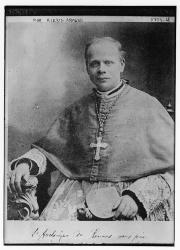Introduction↑
In November 1913, Alexis-Armand Charost (1860-1930) became the first bishop of the newly-created bishopric of Lille, formed from the division of the diocese of Cambrai. Soon afterwards, in September 1914, Lille, along with much of the Nord department, was invaded by the Germans, who occupied the area from October 1914 until October 1918. Charost remained at his post during the invasion and, as a local notable, was among the first individuals taken hostage by the Germans to secure the good behavior of the population.
Occupation Role↑
Charost continued to play an important role during the occupation. Alongside the mayor of Lille, Charles Delesalle (1850-1923), the prefect of the Nord Félix Trépont (1863-1949), later acting prefect Maurice Anjubault (1876-1930), he met the German governor of Lille multiple times a week throughout the war. All three frequently protested against German orders at these meetings and via letters. Charost mostly intervened regarding perceived humanitarian issues, for example calling for the release of imprisoned clergymen or civilians, especially those of lesser means. His most vociferous protest expressed disgust at the April (Easter) 1916 deportation of 20,000 men, women and children from Lille, Roubaix and Tourcoing. He argued that this breached international law, and threatened the institution of the family and morality more generally.
Charost encouraged charitable and social works, notably organizations combatting prostitution and juvenile delinquency, or providing goods to the destitute. Further, he tried, as far as possible, to maintain normal religious life in his diocese, which was cut off from the Vatican and financially strained. He thus stubbornly but vainly opposed the German requisition of Church property and goods, a serious problem from late 1916 when copper requisitions resulted in church bells being taken, melted down, and used for munitions.
Preaching a Complex Message↑
Charost’s understanding of events was complex. Before the war, he was an anti-modernist royalist, heavily critical of the Third Republic’s anticlericalism. The war and occupation simply reinforced his opinions: he preached that the suffering of the French and specifically of the occupied population represented God’s punishment for the sins of the republic; the local people under occupation were “expiatory victims for the faults of France.” Yet not all of his sermons were innocent: in March 1916, Charost upset the congregation by claiming that an explosion at a munitions factory in January 1916, in which 134 people were killed and 400 injured, was divine punishment because most victims were not “for the church” and the children did not go to catechism.
However, Charost supported the Union sacrée and worked with lay notables during the occupation to attempt to protect the population. He also preached unwavering faith in an Allied victory, proclaiming in March 1916, for instance, that the French would win the Battle of Verdun and end the war. He hoped that when this came, given Catholic participation in the war effort, the Church would reclaim its rightful place in public life. Diaries and memoirs attest that such patriotic sermons had a positive effect on local morale – as did Charost’s protests.
After the Occupation↑
Charost was present at the liberation ceremonies of October 1918, and published his own account of the occupation and liberation later that year. He was remembered as a key occupation personality, often featuring and receiving praise in inter-war memoirs. Charost remained bishop of Lille until June 1920, when he was transferred to Rennes, eventually becoming its archbishop and remaining in this position until his death.
James E. Connolly, University of Manchester
Section Editor: Emmanuel Debruyne
Selected Bibliography
- Charost, Alexis-Armand: La délivrance de Lille, Lille 1918: La Croix du nord.
- Cnudde-Lecointre, Carine: Monseigneur Charost, évêque de Lille durant la Grande Guerre, in: Revue du Nord 80/325, 1998, pp. 355-366.
- Cnudde-Lecointre, Carine: L'Église et la foi dans le Nord durant la Grande Guerre. La vie religieuse du diocèse de Lille en 1914-1918, thesis, Lille 1995: Université de Lille 3.
- Connolly, James E.: The experience of occupation in the Nord, 1914-1918, Manchester 2018: Manchester University Press.
- Hilaire, Yves-Marie (ed.): Histoire du Nord Pas-de-Calais. De 1900 à nos jours, Toulouse 1982: Privat.









